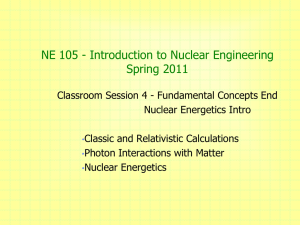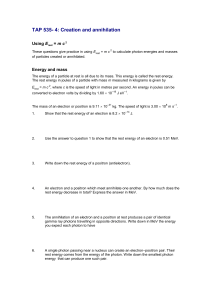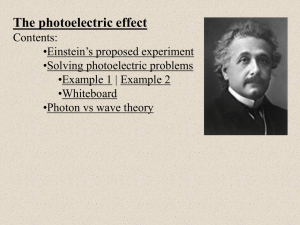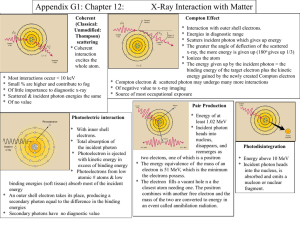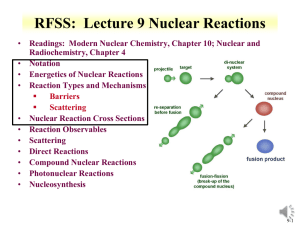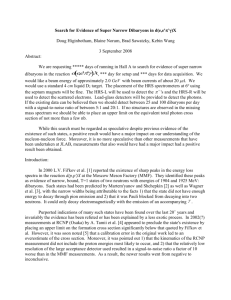4Pair_Production
advertisement
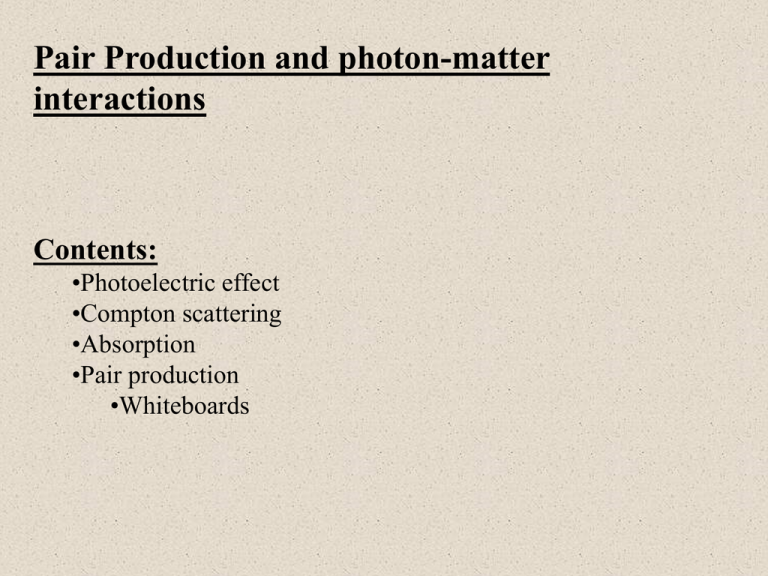
Pair Production and photon-matter interactions Contents: •Photoelectric effect •Compton scattering •Absorption •Pair production •Whiteboards Photoelectric effect 1. Photon knocks electron from atom 2. Photon disappears in the process TOC Compton Scattering 1. Photon bounces off electron 2. Electron absorbs some energy 3. Photon has longer wavelength after collision TOC Absorption 1. 2. 3. 4. Photon hits electron in orbital Electron moves to excited state Photon disappears in the process Only for photons with the right energy TOC Pair production 1. Photon with sufficient energy passes near nucleus 2. Energy of photon turns into matter 3. Pair matter/anti Help me!ofI’m going to bematter is created presently! 4.annihilated Nucleus must carry off some momentum Positron m = 9.11 x 10-31 kg Charge = +e Electron m = 9.11 x 10-31 kg Charge = -e TOC Solving pair production E = hf = hc/ E = mc2 E - Energy m - mass c = 3.00 x 108 m/s 1 eV = 1.602 x 10-19 J So matter can turn to energy and vice versa. Example 1: What energy is needed to create a single electron in J and in MeV? (an MeV = 1 x 106 eV) TOC Solving pair production E = hf = hc/ E = mc2 E - Energy m - mass c = 3.00 x 108 m/s 1 eV = 1.602 x 10-19 J Example 2: What energy photon (in MeV) is needed to create a electron-positron pair each with a kinetic energy of .34 MeV? What is the wavelength of that photon? Photon energy = energy to create matter + kinetic energy TOC Solving pair production E = hf = hc/ E = mc2 E - Energy m - mass c = 3.00 x 108 m/s 1 eV = 1.602 x 10-19 J Example 3: A .00025 nm photon creates a electron positron pair. What is the kinetic energy of each particle? TOC Whiteboards: Pair production 1|2|3 TOC A photon creates a electron-positron pair each with a kinetic energy of .170 MeV. What is the energy of the photon? (in MeV) photon energy = energy to create mass + kinetic energy = .511 MeV + .511 MeV + .170 MeV + .170 MeV = 1.362 MeV 1.362 MeV W A 2134 MeV photon creates a proton, negatron pair, each with how much kinetic energy? (2) Proton rest mass = 938 MeV photon energy = energy to create mass + kinetic energy 2134 MeV = 938 MeV + 938 MeV + kinetic energy kinetic energy = 258 MeV/(2 particles) = 129 MeV 129 MeV W A photon with a wavelength of 5.27113x 10-13 m creates a electronpositron pair with how much kinetic energy each? (answer in keV) E = hf = hc/ E = hc/, = (6.626 x 10-34 Js)(3.00 x 108 m/s)/(5.27113x 10-13 m) = (3.77111x 10-13 J)/(1.602 x 10-19 J/eV) = 2354000 eV = 2354 keV photon energy = energy to create mass + kinetic energy 2354 keV= 511 keV + 511 keV + kinetic energy kinetic energy = 1332 keV/(2 particles) = 666 keV 666 keV W So - is light a wave or a particle? Wave behaviour: Refraction Interference Diffraction Particle behaviour: Photoelectric effect Compton scattering Absorption Pair production What is light? Complementarity - Using a variety of models to describe a phenomenon. Wave behaviour Particle behaviour Light is described totally by both wave and particle behaviour For a given experiment, light is a wave xor a particle
